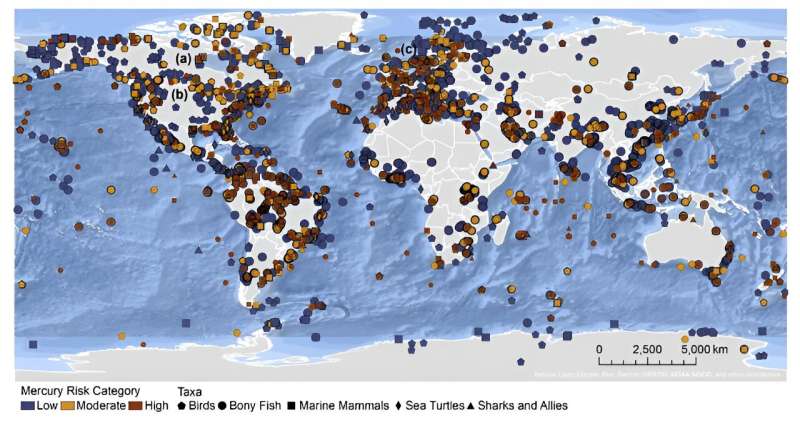This article has been reviewed according to Science X's editorial process and policies. Editors have highlighted the following attributes while ensuring the content's credibility:
fact-checked
peer-reviewed publication
proofread
Researchers investigate mercury concentrations in fish and wildlife on a global scale

A paper, titled "Global Mercury Concentrations in Biota: Their Use as a Basis for a Global Biomonitoring Framework" and published in the journal Ecotoxicology, describes for the first time currently available mercury data for fish and wildlife on a global scale. Data from the peer-reviewed literature, compiled in the Global Biotic Mercury Synthesis (GBMS) database of the Biodiversity Research Institute (BRI), will help inform worldwide efforts to reduce the impact of mercury pollution on people and the environment.
"An important provision of the Minamata Convention on Mercury is to monitor and evaluate the effectiveness of the adopted measures and their implementation," says David Evers, Ph.D., BRI's executive director and chief scientist, and lead author on the paper.
"During the negotiations for the Convention, we recognized that capturing mercury data into a central location was key to evaluating how effective the treaty could be. We knew that a global database that provided a standardized and comprehensive platform for understanding mercury concentrations at spatial and temporal scales would be critical for establishing a biomonitoring framework that would be needed to track mercury concentrations in biota worldwide."
Since 2013, BRI has been developing the GBMS database, which currently contains more than 588,000 data points from individual organisms sampled from more than 4,100 locations in a total of 139 countries. The paper represents the work of 32 researchers collecting data over the course of more than a decade from 1,700 peer-reviewed scientific published papers.
"The breadth and depth of this endeavor cannot be overstated," says Luis Fernandez, Ph.D., executive director of the Center for Amazonian Scientific Innovation (CINCIA), research professor of biology at Wake Forest University, and co-author on the paper.
"Because of the extensive number of individuals, populations, species, and families of biota adversely impacted by methylmercury, researchers can now identify locations in the world where the most sensitive ecosystems overlap with important biodiversity areas and which species are at most risk. This information is critical in the race to prevent loss of biodiversity."
Major findings
- Mercury contamination is ubiquitous in global marine and freshwater.
- Mercury concentrations in freshwater and marine fish, sea turtles, birds, and marine mammals vary greatly by species—best indicators for mercury biomonitoring are identified for all continents and ocean basins.
- Based on over 1,700 references and nearly 600,000 data points, mercury body burdens regularly exceed adverse effect levels across freshwater and marine fish, birds, and marine mammals.
- Data gaps of biotic mercury data for freshwater and terrestrial ecosystems are largest in Africa, Asia, and Australia; for marine ecosystems, Southern Hemisphere Ocean basins have the fewest data.
- Many potential food items, especially certain fish and marine mammal species, often contain methylmercury concentrations that exceed safe levels for human.
- Marine fish of interest and greatest risk to human health include the larger species of tuna, billfish, sharks, barracuda, and some grouper and mackerel species.
- A global meta-analysis demonstrates that over two-thirds of tuna, billfish, shark, and toothed marine mammal species exceed food safety levels for people; geographic areas of concern for healthy fish consumption include the Mediterranean Sea and freshwater systems in South America and parts of North America.
- It is feasible to generate cost-efficient and reliable biomonitoring approaches at geographic scales of interest that can be integrated with existing local and regional mercury biomonitoring networks.
- There is an urgency to monitor and assess the influence of methylmercury on biota because of the potential adverse impacts to biological diversity.
Article 17 of the Minamata Convention on Mercury provides that Parties facilitate the exchange of information including scientific, technical, economic, and legal information concerning mercury and mercury compounds, including toxicological, ecotoxicological and safety information.
"BRI's global mercury database is expected to provide scientific backing in planning and taking stock of national and international measures to control mercury supply and trade, reduce the use, emissions and releases of mercury, raise public awareness, and build the necessary institutional capacity," says Eisaku Toda, senior program officer, Secretariat of the Minamata Convention on Mercury.
In collaboration with the Minamata Convention, BRI has been working to build the GBMS database through studies across the world and shares this information online. "Ultimately, understanding the biotic response to methylmercury availability in the environment for all biomes and key biota over this next decade is vital for evaluating the effectiveness of the Minamata Convention," says Evers.
More information: David C. Evers et al, Global mercury concentrations in biota: their use as a basis for a global biomonitoring framework, Ecotoxicology (2024). DOI: 10.1007/s10646-024-02747-x
Journal information: Ecotoxicology
Provided by Biodiversity Research Institute (BRI)





















